Buenos Aires Underground 200 Series
The 200 Series is a set of underground cars manufactured by China CNR Corporation and CITIC Construction for use on Line A of the Buenos Aires Underground in Argentina.[1] The cars were made in order to replace the 100-year-old La Brugeoise cars which operated on the line up until 2013. The Buenos Aires Underground ordered 45 of these units, followed by a further 105 which are currently being integrated into the line.[2]
| 200 Series | |
|---|---|
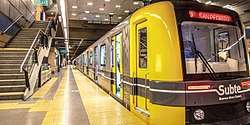 A 200 Series train at San Pedrito | |
| Manufacturer | China CNR Corporation CITIC Construction |
| Constructed | 2012-2015 |
| Entered service | 2013 |
| Number built | 150 |
| Number in service | 55+ |
| Formation | 3M+2T |
| Capacity | 1,148 (seated) |
| Operator(s) | Buenos Aires Underground |
| Line(s) served | |
| Specifications | |
| Car body construction | Stainless steel |
| Doors | 4 per side |
| Maximum speed | 80 km/h |
| Track gauge | 1,435 mm (4 ft 8 1⁄2 in) standard gauge |
Background and overview
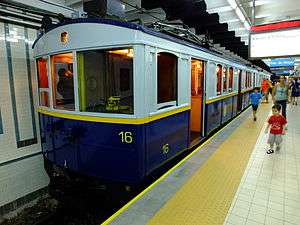
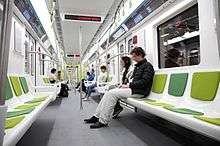
Since the opening of Line A in 1913, it had used the same La Brugeoise et Nicaise et Delcuve rolling stock (along with a small number of UEC Preston cars at one point).[3] Over the years, numerous attempts were made at replacing the rolling stock on the line, though this proved challenging due to its tight curves and use of 1100 volt current instead of the 1500 volts used on the rest of the network.
One such attempt was the Alstom Metropolis cars purchased at the turn of the 21st century, however these ultimately ended up serving on Line D.[4] Before then, an attempt at creating a single, standardised rolling stock model for the entire network had been made in the 1980s in the form of the Fiat-Materfer cars produced in Argentina, which had also been designed to easily switch from 1500 V to 1100 V with Line A in mind.[5] The Materfer cars also didn't make it to Line A at their time of production, though some are used on the line today as stand-ins for the C200 Series units which are yet to arrive from China.[6]
In 2008, 45 of the CITIC-CNR cars (tailor-made for Line A) were ordered by the National Government for the network at a cost of $3 million per car.[7] However, this was still short of the 120 La Brugeoise cars operating on the line at that point and the addition of Puán and Carabobo stations in 2008 meant that the rolling stock was already stretched to full capacity. Furthermore, the opening of San José de Flores and San Pedrito stations was planned for 2013, which was also the date the CITIC-CNR trains were set to arrive along with the retirement of the La Brugeoise cars.[8]
The cars arrived in 2013 and the line was temporarily closed down at the start of that year in order to convert the voltage to 1500 V for their integration, as well as newer forced ventilation systems to accommodate for the hot air extracted by the air conditioning units of the new rolling stock.[6] The line re-opened in March 2013 with the 45 cars operational. They were praised for their quiet operating noise (the lowest in the network) and for their inclusion of newer features such as air conditioning, automated announcements and good lighting - which the 100-year-old La Brugeoise cars did not feature.[9][10]
Shortages and new order
By 2013, Line A was 3 km longer, with four more stations than what the 120 La Brugeoise cars once gave service to. This caused a serious shortage of rolling stock and Fiat-Materfer cars were brought in - along with some Siemens-Schuckert Orenstein & Koppel cars taken out of retirement and remodelled - to make up for these shortages.[11]
In 2014, the City of Buenos Aires purchased another 105 of the 200 Series cars at a much lower cost of $1.53 million per unit, given that the R&D had already been done.[12] This would bring the total to 150 cars on the line - 30 more than the amount of La Brugeoise cars serving on the line before its two extensions.[13] The first cars from the second order began to arrive in the port of Buenos Aires in early 2015, with the rest set to arrive at a steady pace through late 2016 to early 2017, gradually replacing the temporary Siemens and Materfer stock on the line until it is made up entirely of the Chinese trains.[8][14]
Nevertheless, the shortage experienced from the initial lack of a full fleet upon the line's re-opening has led to a serious decline in passenger numbers on the line given its reduced frequencies, which are not expected to recuperate until late 2015.[14]
Gallery
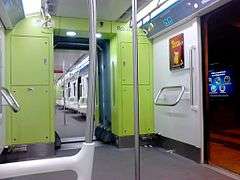 Entrance of the cars
Entrance of the cars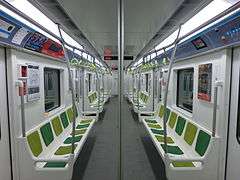 Interior of one of the cars
Interior of one of the cars.jpg) Conductor's cabin
Conductor's cabin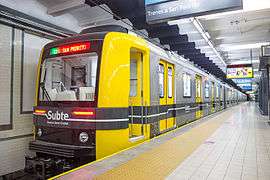 A 200 Series train at Plaza de Mayo
A 200 Series train at Plaza de Mayo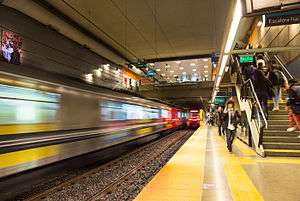 200 Series trains passing each other at San José de Flores station.
200 Series trains passing each other at San José de Flores station.
See also
| Wikimedia Commons has media related to CITIC-CNR (Buenos Aires Metro). |
References
- Metro car for Argentina Archived 2014-10-24 at the Wayback Machine - CNR Corporation Ltd.
- El subte pasó a la Ciudad: qué puede cambiar en el servicio - Clarin, 1 January 2013.
- Los viejos vagones del subte volverán a circular como un paseo turístico - Clarin, 3 September 2013.
- Finalizó la entrega de los Alstom Metrópolis - EnElSubte, 9 March 2009.
- Ferrofilatelia - EnElSubte, 6 June 2010.
- La línea A de subte estará cerrada desde el 12 de enero al 8 de marzo - La Nacion, 4 January 2013.
- Trenes manchados - EnElSubte, 12 November 2008.
- La extensión de la red de subterráneos - Buenos Aires Ciudad, 6 September 2013.
- Con aire acondicionado y sin sacudidas, en la línea A de subte - La Nacion, 15 February 2015.
- Subte Ruidoso - EnElSubte, 23 June 2015.
- SBASE reconoce que la frecuencia de la línea A es “inadmisible” - EnElSubte, 5 March 2014.
- Preadjudican 105 coches a CNR para la línea A - EnElSubte, May 2013
- Hacienda aprueba contrato de financiamiento para 105 coches CNR - EnElSubte, 24 July 2014.
- Incorporarán nuevos trenes a la línea A: realizan pruebas - EnElSubte, 5 June 2015.